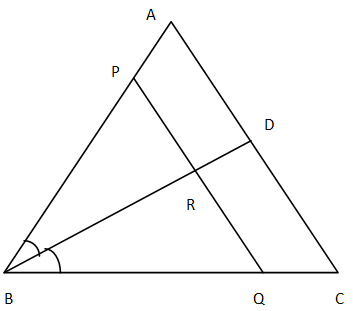
In $\vartriangle ABC$, the bisector of$\angle B $meets $AC$ at $D$. A line $PQ\parallel AC$meets $AB,BC$ and $BD$ at $P,Q$ and $R$ respectively. Show that
$\left( i \right)PR.BQ = QR.BP$
$\left( {ii} \right)AB \times CQ = BC \times AP$


Answer
610.8k+ views
Hint: - The problem can be solved easily using the Intercept theorem.
Given $\vartriangle ABC$ in which $BD$ is the bisector of$\angle B$ and a line $PQ\parallel AC$meets $AB,BC$ and $BD$ at $P,Q$ and $R$ respectively.
For proof \[\left( i \right)\]
Considering small $\vartriangle BQP,BR$ is the bisector of$\angle B$.
Using the properties of similar triangles we have
$
\therefore \dfrac{{BQ}}{{BP}} = \dfrac{{QR}}{{PR}} \\
\Rightarrow BQ.PR = BP.QR \\
\Rightarrow PR.BQ = QR.BP \\
$ (Rearranging the terms amongst themselves)
For proof \[\left( {ii} \right)\]
In$\vartriangle ABC$ we have
$PQ\parallel AC$ (Given in the question)
$
\Rightarrow \dfrac{{AB}}{{AP}} = \dfrac{{CB}}{{CQ}} \\
\Rightarrow AB \times CQ = CB \times AP \\
\Rightarrow AB \times CQ = BC \times AP \\
$ (By using intercept theorem and then rearranging the terms)
Note: - The intercept theorem, also known as Thale’s theorem or basic proportionality theorem, is an important theorem in elementary geometry about the ratios of various line segments that are created if two intersecting lines are intercepted by a pair of parallels. In order to use the Intercept theorem, the first and foremost thing is to recognize the triangle correctly.
Given $\vartriangle ABC$ in which $BD$ is the bisector of$\angle B$ and a line $PQ\parallel AC$meets $AB,BC$ and $BD$ at $P,Q$ and $R$ respectively.
For proof \[\left( i \right)\]
Considering small $\vartriangle BQP,BR$ is the bisector of$\angle B$.
Using the properties of similar triangles we have
$
\therefore \dfrac{{BQ}}{{BP}} = \dfrac{{QR}}{{PR}} \\
\Rightarrow BQ.PR = BP.QR \\
\Rightarrow PR.BQ = QR.BP \\
$ (Rearranging the terms amongst themselves)
For proof \[\left( {ii} \right)\]
In$\vartriangle ABC$ we have
$PQ\parallel AC$ (Given in the question)
$
\Rightarrow \dfrac{{AB}}{{AP}} = \dfrac{{CB}}{{CQ}} \\
\Rightarrow AB \times CQ = CB \times AP \\
\Rightarrow AB \times CQ = BC \times AP \\
$ (By using intercept theorem and then rearranging the terms)
Note: - The intercept theorem, also known as Thale’s theorem or basic proportionality theorem, is an important theorem in elementary geometry about the ratios of various line segments that are created if two intersecting lines are intercepted by a pair of parallels. In order to use the Intercept theorem, the first and foremost thing is to recognize the triangle correctly.
Recently Updated Pages
Master Class 9 Social Science: Engaging Questions & Answers for Success

Master Class 9 Science: Engaging Questions & Answers for Success

Master Class 9 English: Engaging Questions & Answers for Success

Master Class 9 Maths: Engaging Questions & Answers for Success

Master Class 11 Economics: Engaging Questions & Answers for Success

Master Class 11 English: Engaging Questions & Answers for Success

Trending doubts
Which places in India experience sunrise first and class 9 social science CBSE

Fill the blanks with the suitable prepositions 1 The class 9 english CBSE

Write the 6 fundamental rights of India and explain in detail

Difference Between Plant Cell and Animal Cell

What is the Full Form of ISI and RAW

Golden Revolution is related to AFood production BOil class 9 social science CBSE





